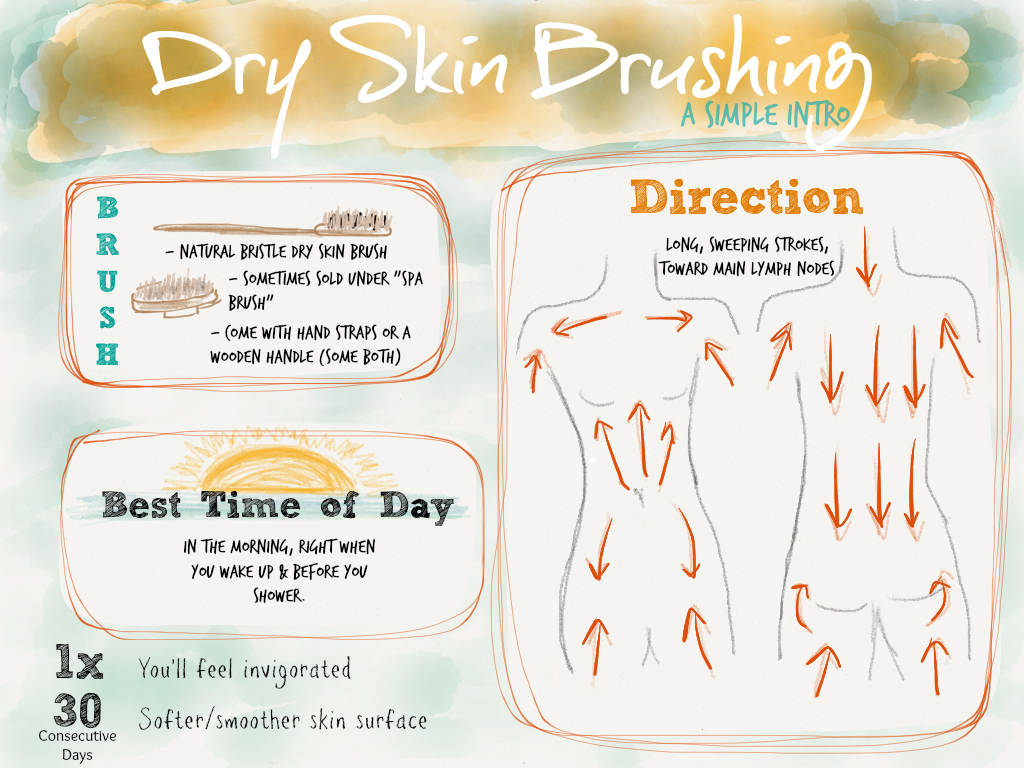Practicing Magic: Dry Brushing – The Simple Skin Healer
Name: Dry Brushing (Garshana)
Most Commonly Found: Dry brushing is now a common practice throughout the world, but it originated as both an Ayurvedic practice in India and has also been used for centuries by Scandinavians and Russians.
Stone Cold Facts: Dry brushing is exactly how it sounds – brushing the skin in a particular pattern with a dry brush, usually before showing. In the ancient technique, the skin is typically brushed toward the heart, starting at the feet and hands and brushing toward the chest.
[Related: Dry Brushing: A Simple Way to Cleanse Your Skin & Body]
What to Heal: Besides feeling great and giving a person softer skin, dry brushing has countless health benefits.
For one, it offers significant lymphatic support, helping the body’s immune system. The lymphatic system consists of organs and lymph nodes, ducts and vessels that transport lymph throughout the body. These vessels run just below the skin and many say that brushing helps stimulate the normal lymph flow throughout the body (Wellness Mama).
Dry brushing also exfoliates the skin, helping loosen and remove dead skin cells, which leads to softer skin. It also helps clean pores, removing oil, dirt and residue from the pores.
In addition, some say that it helps remove cellulite though this benefit has not been proven. It helps with muscle tone as well.
As a whole, it increases energy, blood flow and circulation, making it a great addition to a morning routine. It also calms the mind and increases self-love.

How to Heal: Follow the below steps to get started with dry brushing.
Chopra.com details the steps in a traditional Ayurvedic dry massage:
- Massage your entire body, excluding your face, chest, and heart. Avoid sensitive areas and anywhere the skin is broken or inflamed.
- Use circular strokes on the stomach and joints (shoulders, elbows, knees, wrists, hips, and ankles), and long sweeping strokes on the arms and legs.
- Apply light pressure where the skin is thin, such as the underarms, and harder pressure where the skin is thicker, such as the soles of the feet.
- The direction of the stroke should always be toward your heart as this helps drain lymph back to your heart. Massage from your feet upward, continuing up to your torso and on to your neck. Also, massage from the hands to the shoulders. Continue for at least five minutes.
- Complete your Garshana with a shower.
- To enhance the release of toxins, end with a few cycles of hot then cold water. First turn the water to as hot as you can take it for several seconds, then to as cold as you can tolerate, then back to hot, and so on. This will stimulate the blood circulation and further invigorate the skin.
Related Chakras: Dry brushing throughout the body can help clear up any chakras that are blocked in general.
History + Lore: Variations of skin brushing have been practiced for thousands of years. For example, the Japanese employed vigorous skin brushing with loofah sponges as a prelude to their traditional hot bath. Before washing, the ancient Greek athletes used strigiles to remove the grime of exertion and encourage circulation. The Cherokee Indian dry brushed with dried corn cobs to enhance skin beauty and durability. The Comanche Indians scrubbed their skin using sand from the Texas river bottoms; the Texas Rangers followed their example (Massage Therapy).
Dry brushing has also been used for centuries by Scandinavians and Russians. More than 30 years ago, a Finnish doctor by the name of Paavo Airola prescribed this technique for his patients to detoxify, exfoliate and stimulate the skin.
It also is an ancient Ayurvedic practice that has been around for centuries.
Visit Link

